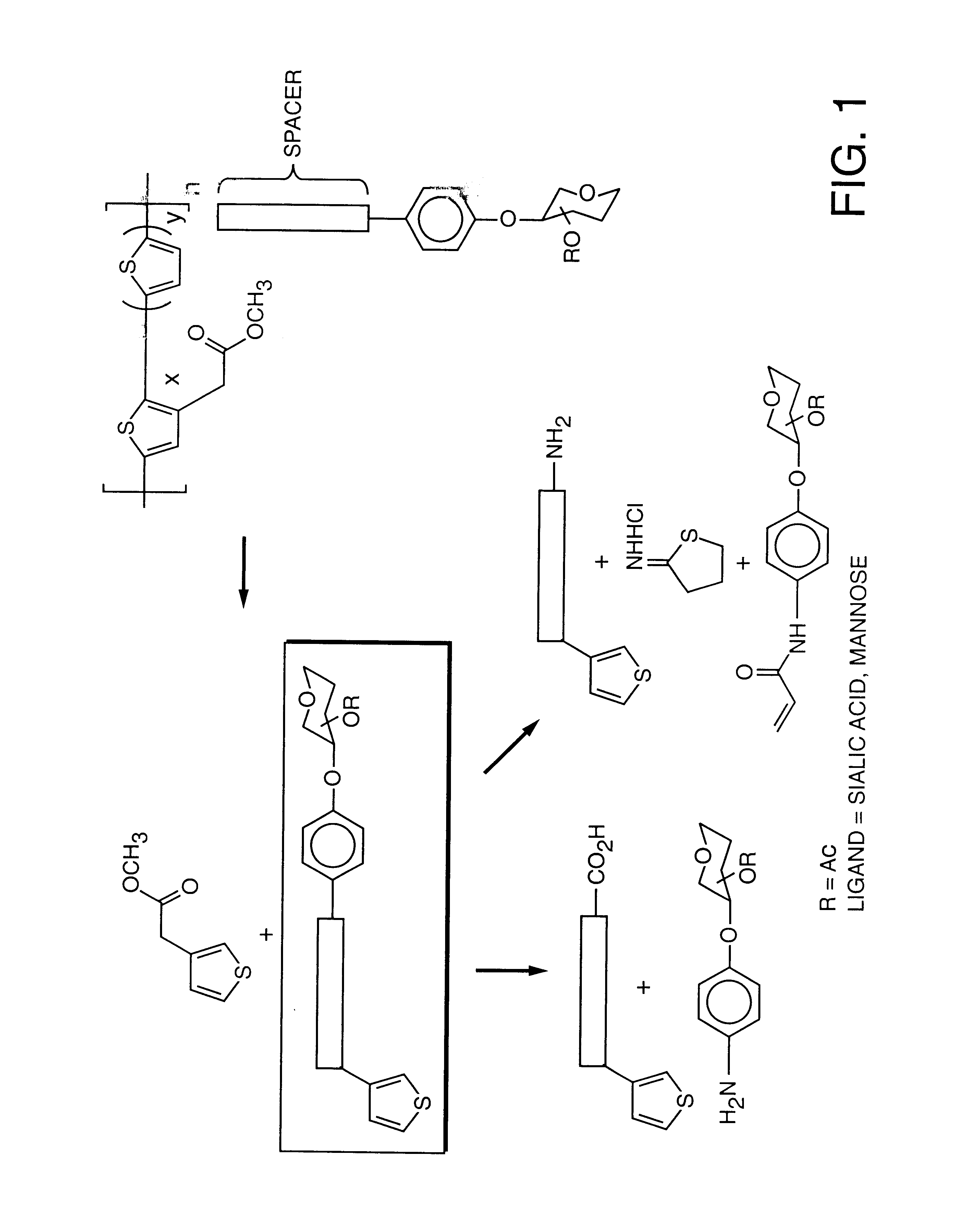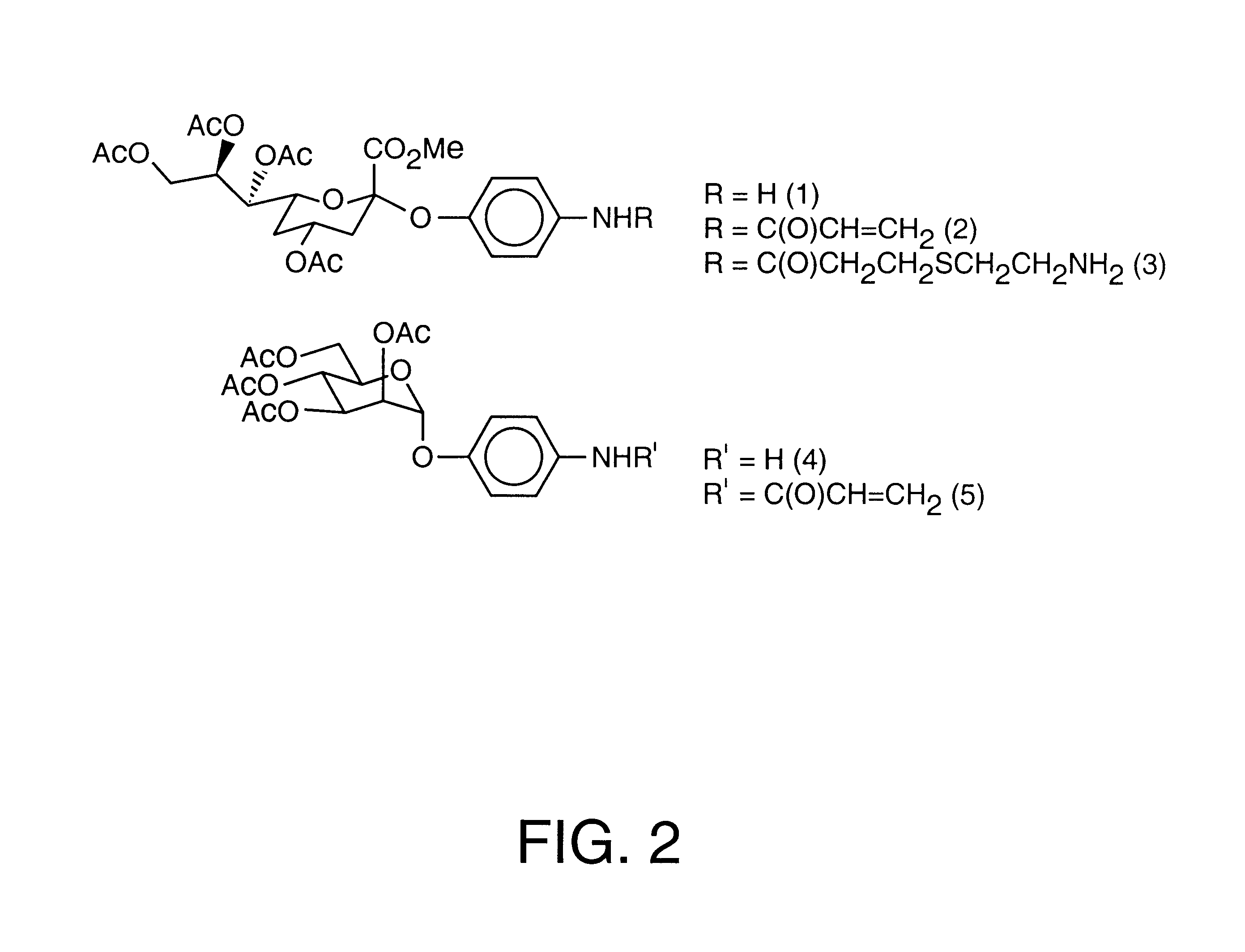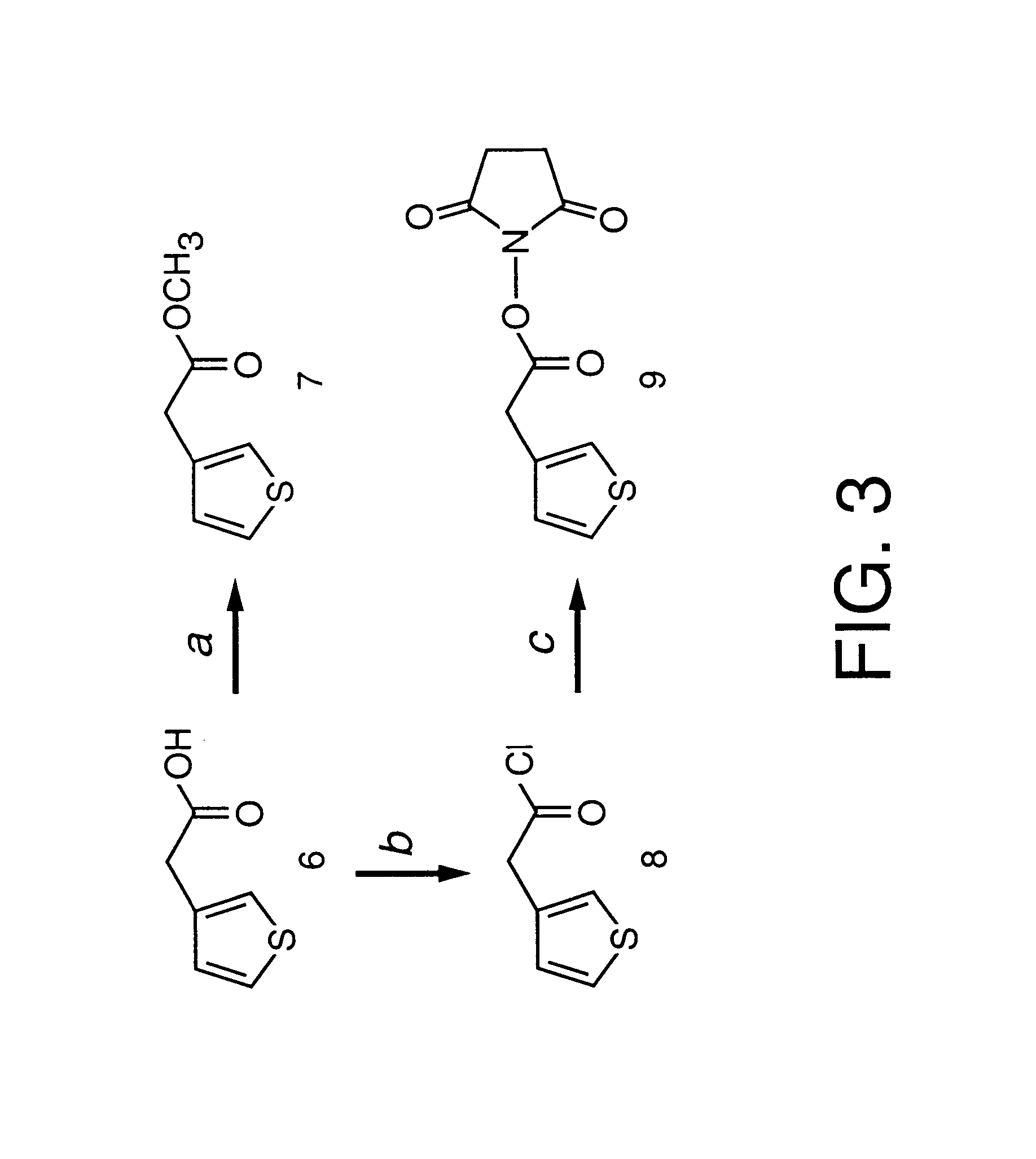Colorimetric glycopolythiophene biosensors
a biosensor and colorimetric technology, applied in the field of colorimetric glycopolythiophene biosensors, can solve the problems of insufficient majority of single devices, difficult or impossible field use adaptation, time-consuming techniques, etc., and achieve the effect of reducing or amplifying the sensing capability of polymers
- Summary
- Abstract
- Description
- Claims
- Application Information
AI Technical Summary
Problems solved by technology
Method used
Image
Examples
example 2
This example describes the various polymerization routines employed in the present invention.
Oxidative polymerization by FeCl.sub.3. To a suspension of FeCl.sub.3 (4 equiv) in dry CHCl.sub.3 (5 mL) was saturated with N.sub.2 and a solution of sugar-thiopene monomer and methyl-3-thiopheneacetate (mole ratio, 1 / 5) mixture in dry CHCl.sub.3 (6 mL) was added dropwise over 2 h period. The mixture was stirred for 3 days at room temperature. The solution was precipitated into MeOH (20 mL), and the brownish solid was collected, washed with MeOH. Polymers were subsequently washed by Soxhlet extraction using MeOH and the residue was dried under reduced pressure to give red-brownish solid. (for sialic acid glycopolymers; 31.about.50% (w / w), for mannose glycopolymers; 28-46% (w / w)).
Graft conjugation of carbohydrates by peptide coupling. TBTU (1.2 eq.) and DIPEA were added to a solution of polythiopheneacetic acid and amine functionalized carbohydrates in DMF. The solution was stir...
example 3
Synthesis of Succinimidyl (3-Thienyl)acetate (Compound 9)
This example describes the synthesis of Succinimidyl (3-Thienyl)acetate (compound 9). Thionyl chloride (0.6 mL, 1 eq.) was slowly added at room temperature to a solution of thiophene-3-acetic acid (1 g, 7.8 mmol) in CHCl.sub.3 (25 mL). The resulting solution was refluxed at 90.degree. C. for 1 h. After the solution was cooled to room temperature, a mixture of N-hydroxy succinimide (0.9 g, 1 eq.) and DIPEA (2.8 mL, 1 eq.) in CHCl.sub.3 (20 mL) was slowly added at ice-water temperature. The solution was then stirred overnight at room temperature. The solution was washed with water then dried over Na.sub.2 SO.sub.4. The solvent was removed by rotary evaporation and the residue was purified by silica gel column chromatography with CHCl.sub.3 / MeOH (40 / 1), or recrystallized with (CHCl.sub.3 / hexane, 1 / 1) after flash silica gel column chromatography to afford yellowish powder in 71% yield (1.32 g, 5.5 mmol). MS (EI): 240.0 (MWH.sup....
example 4
Synthesis of 4-[(3-Thienyl)acetamidolbutanoic acid (Compound 12)
This example describes the synthesis of 4-[3-Thienylacetamido]butanoic acid (compound 12). A couple of drops of DIPEA were added to a solution of thiophene active ester (compound 9) (1.1 g, 4.6 mmol) and 4-aminobutanoic acid (compound 10) (48 g, 4.6 mmol) in CHCl.sub.3 (55 ml) the resulting solution was stirred overnight at room temperature. A white precipitate was filtered off and the filtrate was condensed. Without further work-up, the residue was purified by silica gel column chromatography (CHCl.sub.3 / MeOH, 10 / 1) to give a white solid (0.7 g, 3.1 mmol) in 67.4% yield. MS (EI): 228.0 (MH.sup.+), Mp: 77.3.about.77.6.degree. C., .sup.1 H-NMR (CD.sub.3 OD): .delta.7.27 (dd, 1H, J=3.0 Hz, .sup.4 J=4.7 Hz, thiophene), 7.11 (m, 1H, thiophene), 6.95 (dd, 1H, J=1.1 Hz, .sup.4 J=4.8 Hz, thiophene), 3.44 (s, 2H, thiophene-CH.sub.2), 3.14 (t, 2H, J=6.9 Hz, amide-CH.sub.2), 2.22 (t, 2H, J=7.4 Hz, CH.sub.2 -acid), 1.70 m, 2H, CH...
PUM
| Property | Measurement | Unit |
|---|---|---|
| molecular weight | aaaaa | aaaaa |
| molecular weight | aaaaa | aaaaa |
| temperatures | aaaaa | aaaaa |
Abstract
Description
Claims
Application Information
 Login to View More
Login to View More - R&D
- Intellectual Property
- Life Sciences
- Materials
- Tech Scout
- Unparalleled Data Quality
- Higher Quality Content
- 60% Fewer Hallucinations
Browse by: Latest US Patents, China's latest patents, Technical Efficacy Thesaurus, Application Domain, Technology Topic, Popular Technical Reports.
© 2025 PatSnap. All rights reserved.Legal|Privacy policy|Modern Slavery Act Transparency Statement|Sitemap|About US| Contact US: help@patsnap.com



